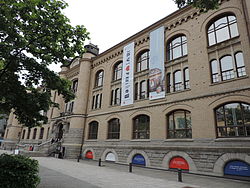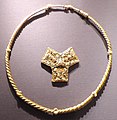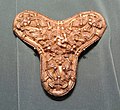Bygdøy or Bygdø is a peninsula situated on the western side of Oslo, Norway. Administratively, Bygdøy is part of the borough of Frogner. It historically was part of Aker Municipality and became part of Oslo in 1948.

Anno Museum in Hamar, Norway is a regional museum for the municipalities of Stange, Hamar, Løten, and Ringsaker in central eastern Norway. It includes the medieval Cathedral Ruins in Hamar mentioned in Sigrid Undset's literary magnum opus Kristin Lavransdatter. The cathedral ruins are secured under a glass shelter designed by Lund & Slaatto Architects and completed in 1998.

Garmo Stave Church is a stave church situated at the Maihaugen museum at Lillehammer in Innlandet, Norway. Garmo Stave Church at Maihaugen is one of the most visited stave churches in Norway.

Tønsberg Fortress was a medieval fortress and castle, located in Tønsberg, Norway which was defended by the fortress for over 300 years.

Norsk Folkemuseum, at Bygdøy, Oslo, Norway, is a museum of cultural history with extensive collections of artifacts from all social groups and all regions of the country. It also incorporates a large open-air museum with more than 150 buildings, relocated from towns and rural districts.

Hanseatic Museum and Schøtstuene is a museum in the city of Bergen, Norway.

Bryggens Museum is a museum located in Bergen, Norway.

Gol Stave Church is a 12th century stave church originally from Gol in the traditional region of Hallingdal in Buskerud county, Norway. The reconstructed church is now a museum and is now located in the Norwegian Museum of Cultural History at Bygdøy in Oslo, Norway.

Lands Museum is the cultural and natural history centre for Nordre and Søndre Land municipalities in Innlandet county, Norway.

The Viking Ship Museum is located on the Bygdøy peninsula in Oslo, Norway. It is temporarily closed from September 2021 until 2027.

The Tune ship (Tuneskipet) is a Viking ship exhibited in the Viking Ship Museum in Bygdøy, Oslo.

Prestfoss is the administrative center of Sigdal municipality in Buskerud, Norway. Highway Fv287 passes through Prestfoss. Both Fv132 and Fv133 start from here.

Nicolay Nicolaysen was a Norwegian archaeologist and Norway's first state employed antiquarian. He is perhaps best known for his excavations of the ship burial at Gokstad in 1880.

The Norwegian Museum of Science and Technology is located in Oslo, Norway. The museum is an anchor point on the European Route of Industrial Heritage.
Alf Bøe was a Norwegian art historian, educator, curator and author.
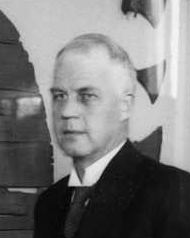
Sigurd Jebsen Grieg was a Norwegian museologist and archeologist. He was director of the Sandvig Collections at Maihaugen in Lillehammer. He is most associated with the excavation of Raknehaugen, a prehistoric burial barrow located at Ullensaker in Akershus, Norway.
Fartein Valen-Sendstad was a Norwegian historian and museologist. He served as Director of Maihaugen in Lillehammer, Norway.

Asbjørn Herteig was a Norwegian archeologist. He was the first curator at the Bryggen Museum and affiliated with the University of Bergen.
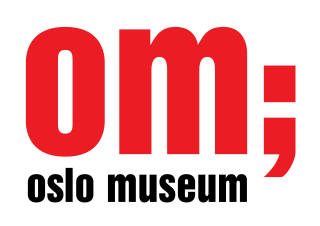
Oslo Museum is a museum dedicated to the history and culture of Oslo, Norway. The museum is headquartered at Frogner Manor in Frogner Park, together with two of its departments; Oslo City Museum and Theatre Museum.

Gerhard Fischer was a Norwegian architect and archaeologist.
